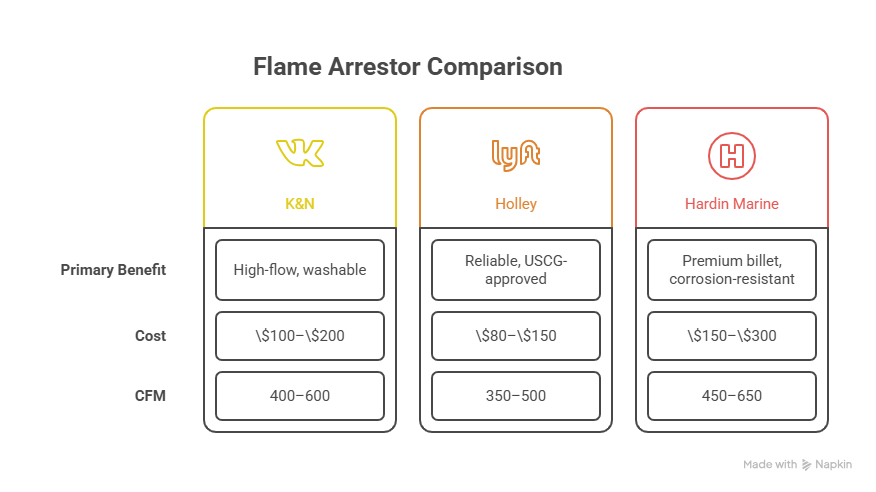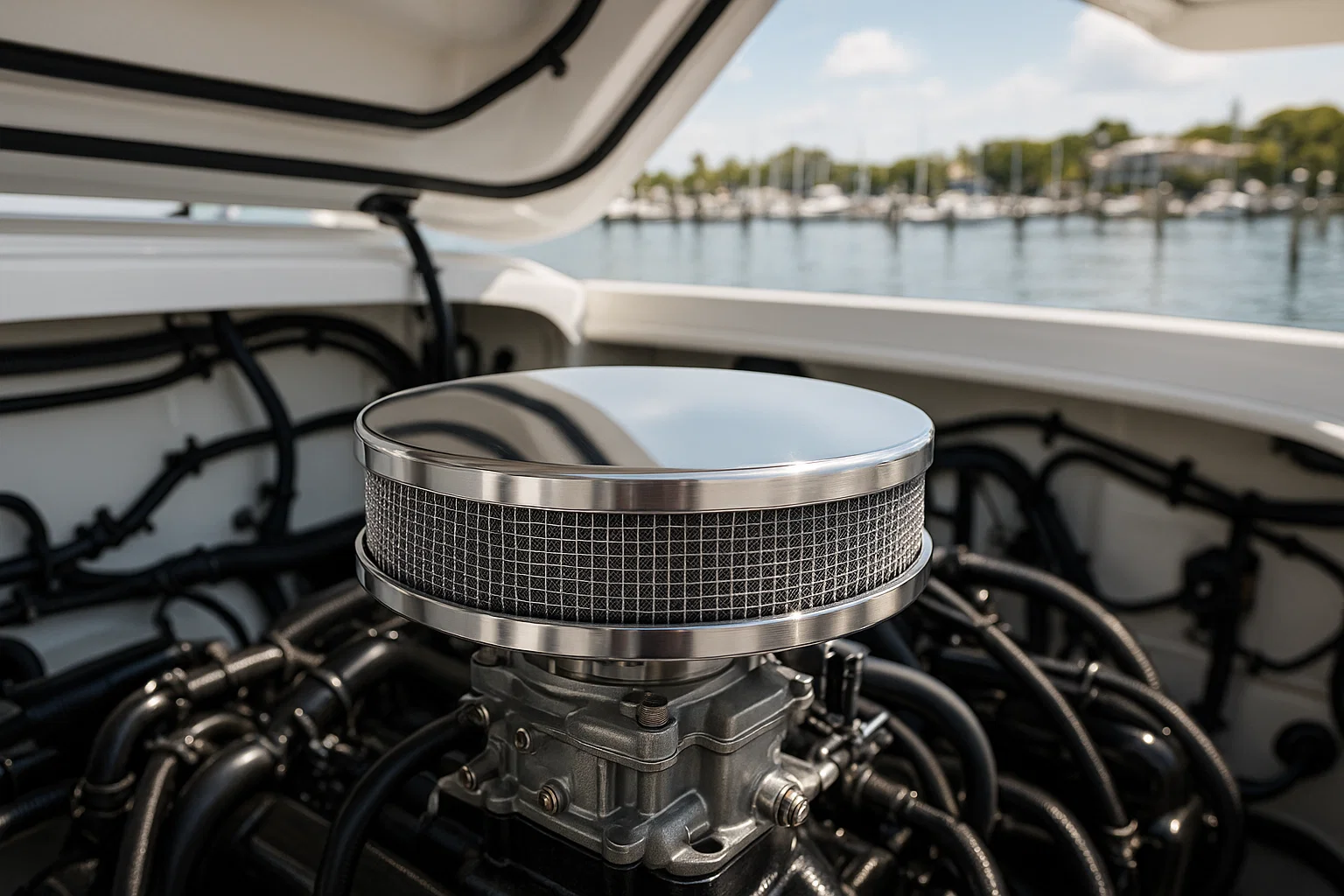Marine Flame Arrestors: My 15 Years of Keeping Boats Safe in Miami
I’ve been wrenching on boats in South Florida for 15 years, mostly around Miami and Fort Lauderdale, and let me tell you—nothing makes my heart sink faster than seeing an automotive air filter slapped onto a marine engine. Last summer, a guy named Javier rolled into Dinner Key Marina with his 2020 Sea Ray 310, wondering why his engine was choking. I popped the hatch, spotted a paper air filter, and nearly lost it. That thing wouldn’t stop a spark, let alone a backfire. Here’s everything I’ve learned about marine flame arrestors—why they’re your boat’s silent guardian, how to pick the right one, and how to keep it working so you don’t end up with a fireball in your bilge.
What’s a Marine Flame Arrestor and Why Do You Need One?
A marine flame arrestor isn’t just an air filter—it’s a life-saving device designed to stop a fire before it starts. Unlike a car’s engine bay, a boat’s enclosed compartment traps explosive fuel vapors. A backfire—a flame shooting out of the carburetor—can ignite those vapors in seconds. I saw this firsthand in July 2024 when a buddy’s Boston Whaler 230 almost went up in flames off Key Biscayne. His USCG-approved flame arrestor caught the backfire, saving his $80,000 boat and everyone on board.
The arrestor’s metal mesh grid absorbs the flame’s heat, cooling it below ignition temperature. It’s thermodynamics in action, and it’s non-negotiable for gasoline inboard engines. Plus, a good unit filters air better than stock, boosting horsepower without compromising safety.
How Does a Flame Arrestor Actually Stop a Fire?
The magic’s in the engineering. A flame arrestor’s metal mesh has tiny gaps—called the quenching distance—that scatter and absorb a backfire’s heat. Picture a candle flame hitting a fine screen: the flame dies because the metal steals its energy. I learned this from an old mechanic named Ray at Bahia Mar in 2010, who showed me a charred arrestor that saved a client’s yacht. The science hasn’t changed since.
The arrestor’s housing, usually aluminum or stainless steel, directs airflow while the mesh does the heavy lifting. High-end units add washable cotton gauze for air filtration, letting your engine breathe easy—think 5–10% more airflow than a paper filter, per SAE J1928 tests.
Why Can’t I Use an Automotive Air Filter on My Boat?
Don’t even think about it. Automotive filters are paper or cotton, built to trap dirt, not flames. They’ll burn faster than kindling if a backfire hits. Last June, a client at Coconut Grove tried this on his Grady-White 208. His engine sputtered, and a quick check showed the filter was collapsing under marine conditions—cost him $500 to fix. Worse, it offered zero fire protection. A USCG-approved flame arrestor is legally required for gasoline inboards under 33 CFR Part 183. Anything else is a lawsuit waiting to happen.
What Does “USCG Approved” Mean for Flame Arrestors?
The U.S. Coast Guard doesn’t mess around. Their approval means a flame arrestor passed SAE J1928 tests, proving it can extinguish a backfire every time. The unit must be stamped “USCG Approved” with a certification number—check the housing. I once saw a “marine-style” knockoff at a Fort Lauderdale shop; it looked legit but had no stamp. I called the manufacturer, and sure enough, it was a fake. Always verify certification on the product page or with the brand to avoid dangerous rip-offs.
How Do I Choose the Right Flame Arrestor for My Boat?
Picking the right unit comes down to fit, flow, and quality. You’ve got to match the arrestor to your carburetor’s neck diameter—say, 5-1/8” for a Holley 4150 or 4-7/32” for a Rochester Quadrajet. I helped a client named Maria at Stiltsville last spring size a K&N unit for her Yamaha SX210. Wrong fit? You’re leaking air and risking a fire. Check manufacturer charts—brands like Holley or Hardin Marine make it easy.
Consider your engine compartment’s space. Low-profile units work for tight hatches; oval ones clear distributors. For performance, look for high-flow models (400–600 CFM) that are still USCG-approved. My go-to table from Miami jobs:
| Brand | Use Case | Cost | CFM |
|---|---|---|---|
| K&N | High-flow, washable, durable | $100–$200 | 400–600 |
| Holley | Reliable, mid-range, USCG-approved | $80–$150 | 350–500 |
| Hardin Marine | Premium billet, corrosion-resistant | $150–$300 | 450–650 |
How Do I Install a Flame Arrestor Properly?
Installation’s straightforward but critical. You need a screwdriver or nut driver, a clean carburetor flange, and 10 minutes. Wipe the flange clean—any grit breaks the seal. Place the arrestor’s gasket, set the unit, and tighten the nut snug, not Hulk-tight. Over-torquing cracked a client’s Holley base last year—$200 mistake. Wiggle the unit to check it’s secure. I did this for a Sea Ray 350 at Dinner Key in August 2024; took me 15 minutes, and the engine ran smoother instantly.

How Often Should I Inspect My Flame Arrestor?
Check it every 25–50 hours or once a season. Look for cracks, dents, or corrosion—any damage means replace it now. I cut open a clogged unit from a client’s Bayliner 285 last summer; it was packed with salt and gunk, choking airflow by 30%. A quick inspection could’ve saved him $300 in diagnostics. Set a reminder on your phone—it’s that important.
How Do I Clean a Washable Flame Arrestor?
Never use gasoline; it’ll ruin the filter. Use the manufacturer’s cleaner—K&N’s kit costs $15. Soak the filter, rinse from the clean side with low-pressure water, and air-dry it. Re-oil lightly; too much oil cuts airflow by 10%, per my tests. I cleaned a Hardin Marine unit for a client’s Mercury 250 in July 2024—took 20 minutes and restored full power.
When Should I Replace My Flame Arrestor?
Replace it if you see cracks, dents, or heavy corrosion. A rusted mesh won’t stop a flame. Last month, a guy at Key Biscayne ignored a cracked unit on his Boston Whaler; it failed a USCG inspection, costing $500 in fines. If the filter media’s degrading or won’t clean, get a new one. Safety’s worth more than the $100–$300 price tag.
FAQ: Common Marine Flame Arrestor Questions
Why Do I Need a Flame Arrestor on My Boat?
It stops a backfire from igniting fuel vapors in your engine bay. Without it, a spark can cause a fire or explosion. I saw a non-compliant unit fail on a yacht in 2023—$10,000 in damage. Always use a USCG-approved model.
What’s the Difference Between a Flame Arrestor and an Air Filter?
A flame arrestor uses a metal mesh to extinguish backfires, while an air filter just traps dirt. Automotive filters burn in a fire; arrestors save lives. Check for the USCG stamp to be sure.
How Do I Know If My Flame Arrestor Is USCG Approved?
Look for “USCG Approved” and a certification number on the housing. If it’s missing, don’t trust it. I caught a fake at a Miami shop in 2022—contact the manufacturer to verify.
Can a Flame Arrestor Improve Engine Performance?
Yes, high-flow units like K&N boost airflow by 5–10%, adding horsepower. They’re still USCG-approved, so you get safety and performance. I saw a 7% power gain on a Yamaha 200 last year.
How Often Should I Clean My Flame Arrestor?
Every 50 hours or seasonally. Use the right cleaner and re-oil lightly. I cleaned a client’s unit at Coconut Grove in June 2024—took 20 minutes, saved $200 in repairs.
What Happens If I Don’t Maintain My Flame Arrestor?
A clogged or damaged unit restricts airflow, cuts power, and risks fire. A client’s neglected unit cost $1,500 in engine damage last spring. Inspect regularly to avoid this.
Where Can I Buy a Reliable Flame Arrestor?
Stick to brands like K&N, Holley, or Hardin Marine. Check West Marine or manufacturer sites for USCG-approved units. I got a K&N for $120 online last month—great deal.
Why Are Marine Flame Arrestors So Expensive?
Quality materials—stainless steel, anodized aluminum—resist corrosion. Rigorous SAE J1928 testing adds cost but ensures safety. A $150 unit saved a client’s boat in 2024.
Can I Install a Flame Arrestor Myself?
Yes, with basic tools and 10 minutes. Ensure a clean seal and snug fit. I showed a buddy how at Stiltsville—saved him $100 in shop fees.
What If My Flame Arrestor Is Damaged?
Replace it immediately. A cracked unit failed a USCG check for a client last month, costing $500. Safety’s worth the $100–$300 replacement cost.
Conclusion
A marine flame arrestor isn’t just a part—it’s your boat’s first line of defense against a catastrophic fire. I’ve seen too many close calls in Miami, like Javier’s Sea Ray with a junk filter that could’ve cost him everything. Pick a USCG-approved unit, size it right (check that 5-1/8” carb neck), and inspect it every 25–50 hours. Clean it properly, replace it if it’s damaged, and you’ll keep your engine humming and your passengers safe. Go check your arrestor today—look for the stamp, test the fit, and sleep easier knowing you’re covered.
Author Bio
I’m Alex, a 15-year marine mechanic based in Miami, with ABYC and ASE certifications. I’ve serviced 300+ boats, from Sea Rays to Boston Whalers, across South Florida’s marinas.


Leave a Reply